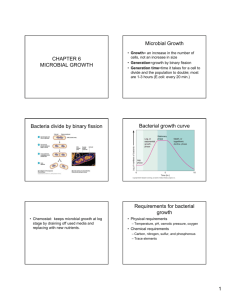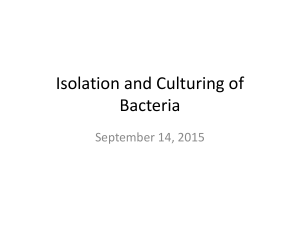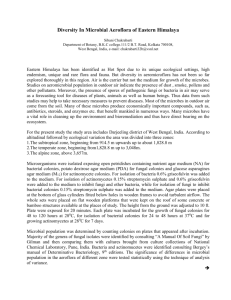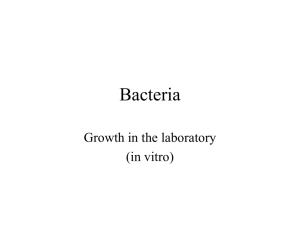Chapter 6: Microbial Growth
advertisement
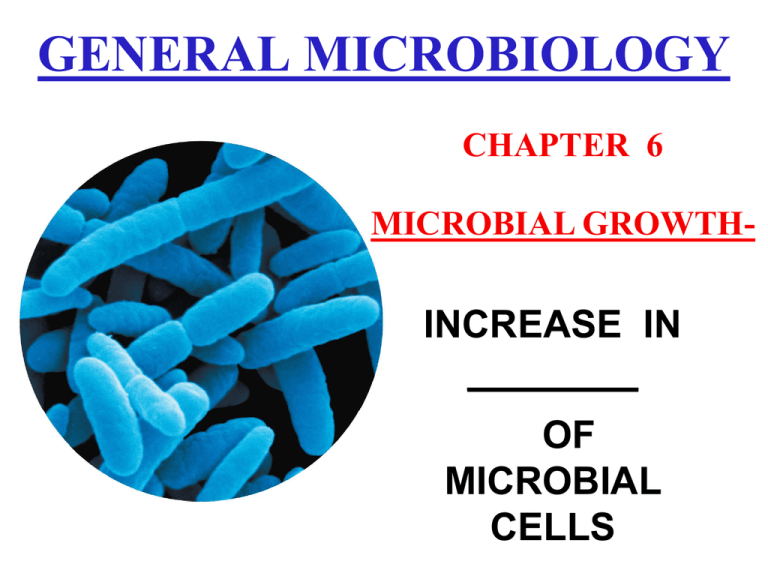
GENERAL MICROBIOLOGY CHAPTER 6 MICROBIAL GROWTH- INCREASE IN ________ OF MICROBIAL CELLS MICROBIAL GROWTH REQUIREMENTS • PHYSICAL – ___________ – pH – osmotic pressure • CHEMICAL – – – – Carbon (C) Oxygen (O) ____________ Sulfur (S) • Phosphorus • _________________ factors • Trace elements PHYSICAL REQUIREMENTS for GROWTH : TEMPERATURE • MINIMUM GROWTH TEMPERATURE – _______ temperature at which a species will grow • OPTIMUM GROWTH TEMPERATURE – Temperature at which species will grow ____ • MAXIMUM GROWTH TEMPERATURE – _______ temperature at which growth is possible CLASSIFICATION OF MICROBES: TEMPERATURE RANGE of GROWTH • __________PHILES - ________ loving microbes • Optimum growth temperature: 15oC • Capable of growing at 0oC, but __________ • Found in ocean depths, polar regions – Psychrotrophs-less temperature sensitive, some food spoilage • ______PHILES - moderate temperature loving microbes – Optimum growth temperature: 25-40oC – Most common microbes – Food spoilage and disease • ________PHILES heat loving microbes • Optimum growth temperature: 50-60oC • Minimum growth temperature: 45oC • Found in hot springs, compost piles ACID BASE CHEMISTRY – ____ – a substance that dissociates into hydrogen ions _____ and negative ions in aqueous solution Ex. Hydrochloric acid, citric acid – BASE – a substance that dissociates into hydroxide ions ____ and positive ions in aqueous solution Ex. Sodium hydroxide pH scale - logarithmic scale used to measure H+ concentration PHYSICAL REQUIREMENTS for GROWTH cntd.: pH – Most bacteria grow between pH __________ – Molds and yeast grow between pH ________ – Acidophiles grow in acidic environments ____ – compounds that keep pH from changing drastically; ex. peptones, amino acids, phosphate salts-very important in the preparation of microbial media!! PHYSICAL REQUIREMENTS for GROWTH cntd. Osmotic Pressure the force used by a solvent in moving from an area with a lower solute concentration to an area of higher solute concentration – ______ environments - concentration of solute (ex. salt or sugar) is higher _____ cell, causes plasmolysis • Results in loss of water from a cell – __________ bacterial growth – Used to preserve food, ex.Salted fish ______philes - require higher salt concentrations in their environment and therefore high osmotic pressure • CHEMICAL REQUIREMENTS for GROWTH • Carbon • – Structural organic molecules, energy source • Chemo__________ use _________ carbon sources • Ex. Humans, fungi, protozoa, most bacteria, helminths • Autotrophs -use CO2 as carbon source Ex. Plants Nitrogen – In amino acids, proteins Sulfur – In __________, thiamine, biotin – Some bacteria use SO42 or H2S Phosphorus – In DNA, RNA, ATP, and membranes – PO43 is a source of phosphorus __________ Elements – Inorganic elements required in small amounts: Fe, Cu, Mb, Zn Organic Growth Factors – Organic compounds obtained from the environment – Vitamins, amino acids, purines, pyrimidines CHEMICAL REQUIREMENTS for GROWTH cntd. - OXYGEN Facultative Obligate anaerobes- anaerobes ____tolerant MicroObligate growth ____ -no growth anaerobesaerophiles _______-O2 can tolerate _______ when O2 need is required when O not O2 but can’t present________ O2 2 for growth use it for present, O2 _________ concentrations growth O2 preferred _______ FORMS of OXYGEN Produced in small amounts during normal metabolic processes-harmful to cells Some Forms of Toxic Oxygen – Superoxide free radicals (O2-1) – very unstable, steal electrons from cellular molecules – Peroxide anion (O2-2) – contained in hydrogen peroxide – Hydroxyl radicals (OH-) – most reactive MECHANISMS of ELIMINATION Superoxide free radicals (02-1) 02- + 02- + 2H+ superoxide dismutase H202 + 02 Peroxide anions (02-2) 2H2O2 __________ 2H2O + O2 H2O2 + 2H+ peroxidase 2H2O ________ CULTURE METHODS 1. _________ media contains chemicals (sodium thioglycolate) that combine with O 2 Media is heated to drive off O 2 2. OxyPlates ________ (oxyrase) that reduces oxygen to water is added to growth media, transforms petri plate into an anaerobic chamber 3. ______________ 4. ANAEROBIC CHAMBER _________PHILES Def.: Bacteria that require _________ concentration ____________ • Microbial communities • Form slime or hydrogels – Bacteria attracted by chemicals via quorum sensing • Share ____________ • Sheltered from harmful factors • Involved in @70% of infections – ________, heart ________, contact lenses, dental caries Figure 6.5 CULTURE MEDIA important terms • Culture Medium: _________ (or any material) prepared for the growth of microbes in a laboratory • Sterile: No _________ microbes • Inoculate: Introduction of microbes into medium • Culture: Microbes growing in/on culture medium • ____ culture - contains only ________ or strain of bacteria • Agar: Complex ___________ (from marine algae) – Used as solidifying agent for culture media in Petri plates, slants, and deeps – Generally not metabolized by microbes – Liquefies at 100°C – Solidifies ~40°C CULTURE MEDIA Chemically Defined Media: Exact chemical composition is known -Fastidious microorganisms- they require many growth factors provided in chemically defined media. _________ Media: Exact chemical composition _______; Extracts and digests of yeast, meats (organs), or plants Ex. Nutrient broth, nutrient agar CULTURE MEDIUM for __________ MICROORGANISMS SELECTIVE MEDIA • ________ unwanted microbes and encourage desired microbes. Ex. Eosin Methylene Blue Agar(EMB) and MacConkey agar-allows Gram___ bacteria to grow but not Gram (+) bacteria. EMB Agar EMB Agar Figure 6.9b, c DIFFERENTIAL MEDIA • Used to ________ colonies of different microbes based on specific properties such as: lactose fermenting bacteria from lactose non-fermenting bacteria; Ex.: MacConkey and EMB agar Lactose Fermenter on___________ Agar Lactose nonfermenter on MacConkey Agar Figure 6.9a BOTH SELECTIVE and DIFFERENTIAL MEDIA 1.MacConkey Agar DIFFERENTIAL SELECTIVE for Gram (-) bacteria 2. Eosin Methylene Blue (EMB )Agar DIFFERENTIAL SELECTIVE for Gram (-) bacteria ENRICHED MEDIA nutritionally fortified media which ___________ the growth of a wide range of microorganisms __________ Plate also differential STREAK PLATE METHOD PROCEDURE for STREAKING for ISOLATION ISOLATED COLONIES on AGAR PLATE ______- a population of cells arising from a __________ or spore or from a group of attached cells A colony is often called a colony-forming unit (CFU) PRESERVING BACTERIAL CULTURES • Deep-freezing: -50°to -95°C • Lyophilization (____________): Frozen (-54° to -72°C) and dehydrated in a vacuum REPRODUCTION in PROKARYOTES • ___________ • Budding • Conidiospores (actinomycetes) • Fragmentation of filaments BINARY FISSION Bacterial Exponential Growth Curve ____________ TIME: Time required for a cell to ______________ Figure 6.13 FOUR PHASES of TYPICAL ___________GROWTH Figure 6.15 METHODS to DETECT and MEASURE BACTERIAL GROWTH (Numbers) • DIRECT – ___________* – Filtration – Most Probable Number (MPN) – Direct Microscopic Count* • __________ – ____________ Measurements* – _____________ Determination – Metabolic Activity Measurements* DIRECT __________ METHOD • Inoculate Petri plates from serial __________ of sample • Used to count _______ bacterial cells only ______ MICROSCOPIC COUNT The number of microbes in a specific volume of bacterial suspension are counted using a special slide Ex.: PETROFF HAUSSER Does not distinguish between living and dead cells Estimating Bacterial Numbers by Indirect Methods ________:_______ Measures number of cells present, dead or alive Figure 620 Estimating Bacterial Numbers by Indirect Methods • ____________ activity – Amount of certain metabolic products is in direct proportion to number of bacteria present – Examples: » O2 Consumption » Acid Production • Dry weight – Weight of packed cell mass is proportional to the number of cells in culture – Used for filamentous fungi

